Cooper T53 and T53P car-by-car histories

Jack Brabham in his championship-winning Cooper T53 F2-8-60 at Oulton Park in September 1960. Copyright GP Library Limited (licenced by Alamy) 2024. Used with permission.
A lower, slimmer and better packaged version of the Cooper T51, the "lowline" Cooper T53 dominated the 1960 season with works drivers Jack Brabham and Bruce McLaren finishing first and second in the World Championship.
The factory had a pair of T53s ready for the BRDC International Trophy in May 1960. Every aspect of the car had been reassessed in search of the greatest possible simplicity, strength, weight and efficiency. The ERSA gearbox was replaced with a new five-speed C5S transaxle designed by Cooper designer Owen Maddock and built by Jack Knight Engineering in London, and the leaf-spring rear suspension that was preferred by Charles Cooper was replaced with the coil-spring strut type suspension that Stirling Moss had used on Rob Walker's T51 in 1959. The 4-cylinder Coventry Climax FPF engine was mounted an inch lower and the driving position was more reclined, earning the car its 'Lowline' nickname. Three successive victories in the Netherlands, Belgium and France gave Brabham a huge championship lead, and despite Moss's best efforts in his Lotus, McLaren scored enough points to finish second in the championship. For 1961, Cooper built a series of production replicas for customers to use in the new 1.5-litre Formula 1. Even Rob Walker bought one for Stirling Moss to use in Intercontinental Formula races. These cars are given the same type number in Cooper records but many historians refer to them as Cooper T53P to distinguish them from the 1960 factory cars.
Any other contributions to this massive jigsaw puzzle would be greatly appreciated. Please email Allen if you can add anything.
Cooper T53 1960 production
The Cooper factory built two new 'lowlines' for the 1960 F1 season, adding a third car as a spare later in the season, and then building a fourth for Jack Brabham to use as a private car.
New for Bruce McLaren in 1960, and used by him in all World Championship races that season. After the United States Grand Prix at Riverside in California on 20 November 1960, the two works T53s were shipped to Ardmore for McLaren to race at the New Zealand GP on 7 January 1961, and at Wigram in 21 January. After that race, Brabham's car went to Australia, but McLaren's presumably returned to England.
It is likely that this was the car that the Atkins team ran for Bruce McLaren during 1961, but there is no direct evidence to support this, and the Atkins car was reported at the time to be new. If this wasn't the Atkins car, then it could well be the car used by Arthur Owen in hillclimbs later in 1960.
Driven by: Bruce McLaren. First race: Silverstone, 14 May 1960. Total of 12 recorded races.
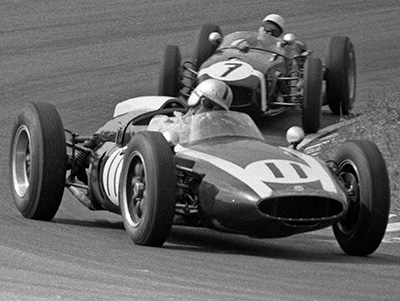
Jack Brabham in his works Cooper T53 battles with Stirling Moss on his way to his first victory of the F1 season at Zandvoort in June 1960. Licenced by Nationaal Archief, CC0 under Creative Commons licence CC0 1.0 Universeel (CC0 1.0). Original image has been cropped.
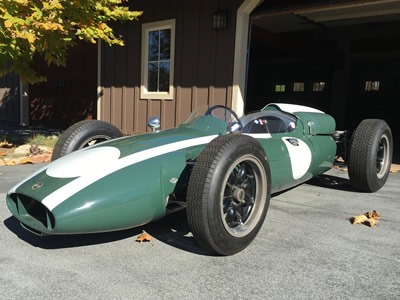
Rodney Smith's Cooper T53 in front of his garage in Carmel Valley November 2015. Copyright Rüdiger Friedrichs 2016. Used with permission.
New for Jack Brabham in 1960, and used by him in all World Championship races his title-winning season. After the United States Grand Prix at Riverside in California on 20 November 1960, the two works T53s were shipped to Ardmore for the New Zealand GP on 7 January 1961. Brabham used F2-8-60 again at the Lady Wigram Trophy on 21 January, and then it had to be rapidly shipped to Australia for the Warwick Farm race on 29 January, as his own car, F2-17-60, had been delayed on its way from South Africa. Photographs show that this New Zealand car was the one Brabham used at the later Australian races. It was returned to England, and was next seen at the Silverstone International Trophy in May 1961, where Ron Flockhart drove it as a Brabham Racing Organisation entry, but crashed in the rain. The car was not seen again in 1961.
In mid-1962, it was sold to Dan Herman (Sebastopol, CA) and shipped to California. Herman planned to fit an American engine for Intercontinental racing but this never went ahead, and in January 1965 he sold it to John Coyle (El Cerrito, CA). It remained with Coyle, again unused and effectively unchanged, until it was sold to Steve Froines (Dublin, CA) in in 1985 or 1986. It was first seen with Froines in 1990, and raced by him at Monterey in 1994 and 1996.
From Froines to Rodney Smith (Portola Valley, CA) by 1999, and raced for him by Mark Gillies at Monterey in 1999, by Jack Brabham at Monterey in 2000, and by Gillies at the Goodwood Revival Meeting 2004. At the Monterey Historics in 2006 when it was listed as "F2/8/60". Smith was killed in a road accident while cycling in May 2007, and the car passed to his widow Mary. Sold to Rüdiger Friedrichs (Würselen, Germany) in December 2015 and taken to the UK for preparation. Raced by Friedrichs at the 2021 Silverstone Classic. Still with Rüdi in February 2024.
Driven by: Jack Brabham and Ron Flockhart. First race: Silverstone, 14 May 1960. Total of 18 recorded races.
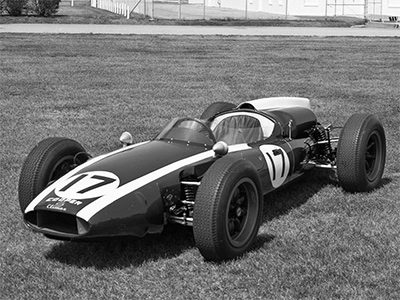
The IMS Museum's Cooper T53 at the Speedway in 1983. Copyright Indianapolis Motor Speedway. Copyright permissions granted for non-commercial use by Indianapolis Motor Speedway.
First seen as a spare car at the Portugese GP 14 Aug 1960, then used by Jack Brabham as a Formula 2 car at Roskilde and Zeltweg in September. The car was then shipped to the Indianapolis Motor Speedway for a two-day test on 5-6 October, where it reached a speed of 144.8 mph, astonishing the Indy community. A few days later, Brabham raced it at Watkins Glen, finishing second in the Watkins Glen International Grand Prix. It was then put on display in London, at Les Leston’s premises at High Holborn from 3 December to 28 December and then rotating on a turntable at the Second Annual Racing Car show in Westminster from 31 December to 7 January 1961.
In 1961, it was used as a spare car for the Indy 500 project but "did not leave the garage". It was then sold to Hap Sharp, who demonstrated it at the Road America 'June Sprints' in 1961, smashing the unofficial lap record. Sharp also won an SCCA National at Watkins Glen in September 1961 where it was described as the "ex-Jack Brabham Cooper-Climax". What happened to the car next is unclear, as Sharp bought a second, brand new, T53 for the United States GP in October. In 1962 he sold one of these cars to Alan Connell and kept the other, but it is unclear which car he sold.
See the Alan Connell car and the Hap Sharp 1962-65 car.
It has been widely reported that this car was donated to the IMS Museum by Jim Hall, Sharp's partner at Chaparral, in 1969 or 1970. The car was on display in May 1970, then described as Brabham's race car. Still in the museum's collection in November 2021.
Driven by: Jack Brabham and Hap Sharp. First race: Roskilde, 11 Sep 1960. Total of 4 recorded races.

Jack Brabham in his Cooper T53 F2-17-60 at Brands Hatch in August 1961. Copyright GP Library Limited (licenced by Alamy) 2024. Used with permission.
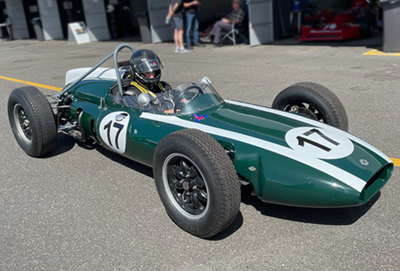
Flavio Puccinelli's newly-restored Cooper T53 F2-17-60 in March 2021. Copyright Flavio Puccinelli 2021. Used with permission.
A new car built late in 1960 for Jack Brabham, and first raced at the South African GP in December 1960. It was then shipped to Australia for the Internationals in February 1961, but delayed in shipping so Brabham used his ex-works T53 F2-8-60 in Australia instead. F2-17-60 was then returned to Europe and was raced by Brabham in Intercontinental and minor F1 races during the 1961 season, until Brabham bought his ex-works T55 to replace it. Both the T55 and F2-17-60 were taken to New Zealand in January, where Brabham drove the older car in three of the 1962 Internationals. The T53 was sold to Lex Davison (Toorak, Victoria, Australia) to replace his crashed F1-2-61, and raced by Davison in 1962 and early 1963.
Davison sold the car in July 1963 to Tony Osborne (Melbourne, Australia), who raced it in 1963 and 1964 before deciding to have it converted into a sports car. Ray Gibbs was commissioned to design and build the 'Argo Sports' at his workshop in Malvern, but the project was badly delayed and the car did not race until 1967, by which time it was uncompetitive. The Argo was fitted with a Chevrolet V8 and was raced by Ian Cook in 1967 and by Peter Macrow in 1968. After Osborne bought a McLaren M4A, the Argo languished in Osborne's garage for many years.
According to Blanden, the Argo used the front end and the rear suspension of the Cooper, and many other bits of the Cooper were sold to Don O'Sullivan in Perth after he crashed his T53. The Climax engines were sold to Bob Jane and to John Roxburgh, and the Cooper C5S gearboxes went to Feo Stanton in New Zealand. Blanden said that the central part of the chassis "was taken to the tip". When Gibbs revealed the rebuilt Cooper T53 in 1983, it was treated with some suspicion at first. It appeared at the Geelong Speed Trials in 1983, and also appeared at events at Winton. By 2002, it was on display at the Len Lukey Museum at the Phillip Island Circuit. The remaining parts of the Argo allowed Gibbs to also recreate the sports car, and by 2011, both cars were on display in the museum.
A careful examination of the Cooper and the Argo in 2011 by David Rapley, widely regarded as Australia’s leading authority on the Cooper marque, revealed that the Cooper contained in David’s view "all period parts and the chassis was obviously heavily repaired from original pieces". As individual components are not numbered, he could not be sure that all the components came from the same car, but with that proviso he concluded that “I believe it contains the vast majority of the original chassis, body, tanks and possibly most other components”. From this evidence, it would appear that the majority of the original chassis frame of the Cooper had not been thrown away, as Blanden had been told, and that Gibbs had - between 1968 and 1983 - reconstructed the original Cooper chassis from the parts used in the Argo.
In 2013, Gibbs' family offered some of his cars for sale, and at this stage it became clear that he had three related cars: the green Cooper T53 that had been in the Lukey Museum; the Argo Sports, also complete; and an orange Cooper T53 of unknown provenance. The Argo Sports was sold, but the two T53s remained with the family until they were sold by Shannons Auctions in July 2018. The green T53, now identified as F2-17-60, was bought by Flavio Puccinelli (Melbourne, Victoria, Australia) and extensively rebuilt, appearing on track at Philip Island in 2019.
Driven by: Jack Brabham, Roy Salvadori, Lex Davison, Tony Shelly and Tony Osborne. First race: East London, 27 Dec 1960. Total of 29 recorded races.
The Production Cooper T53s
Cooper put the championship-winning Cooper 'T53' into production for 1961. One last car was built in 1963.
Built for 1961 season. Yeoman Credit Racing (Reg Parnell Racing) 1961 for John Surtees in F1. Then identified by the Formula 1 Register as the car raced by Tony Maggs in the 1961-62 South African Springbok series. The last appearance by the car was at Killarney on 2 Jan 1962, less than a week before the New Zealand Grand Prix, where the Parnell team had another two T53s present.
According to South African author and historian Rob Young, the Maggs car was sold after the series to a Mr Kilner in Rhodesia, and fitted with an Alfa Romeo engine for 23-year-old Mike Harris (Salisbury, Rhodesia; now Harare, Zimbabwe) to drive. Harris had driven an Alfa Special for Kilner & Swift Motors in 1961. According to the F1 Register, Harris entered his car at Kyalami three times during 1961, on 30 June, 4 August and 10 October, but did not appear, and Harris's first known appearance in his car was at the Rhodesian GP at Kumalo on 2 December, when the first of the British teams had started to appear for the forthcoming 1962-63 Internationals. Harris raced the car at Kumalo (finishing a fine third), then at the Rand GP (retired) and Natal GP (retired from heat) and South African GP (retired). Gary Hocking's death at the Natal GP convinced Harris to then retire, and he and the Cooper did not appear again.
The car was next seen nearly two years later when, according to Duncan Rabagliati of the Formula One Register, it was the Cooper-Alfa driven by Rhodesian Bruce Huntley at three races in late 1963: the Rand Spring Trophy at Kyalami on 10 October 1963, the Rhodesian Grand Prix on 1 December 1963, and the Rand Grand Prix at Kyalami on 14 December 1963, where he did not start.
In late 1966, the T53 reappeared, entered by Vic Drummond for Gordon Littleford, again with an Alfa Romeo engine. According to the F1 Register, it was raced by Gert Coetzer once in 1967, but Rob Young advises that it was John Coetzer, a Rhodesian driver, who "wiped out" the Cooper at Kyalami in 1967.
Subsequent history unknown, but see the Ivan Glasby car.
Driven by: John Surtees, Tony Maggs and Mike Harris. First race: Lombank Trophy, 25 Mar 1961. Total of 20 recorded races.
Built for 1961 season. Yeoman Credit Racing (Reg Parnell Racing) 1961 for Roy Salvadori in F1. To Lex Davison (Australia) 1962 and crashed at Longford. Replaced by Jack Brabham's spare car 'F2-17-60'. F1-2-61 was sold damaged to Don Fraser (Australia) 1963, who rebuilt it with a 2.5-litre BRM engine and raced it from 1965 onwards. To Tony Osborne (Australia) 1976. To Don Thallon (Brisbane, Australia) May 1999 and used in historic racing. Raced by Thallon at Zandvoort in 2014 alongside Wulf Goetze's 'F1-1-61' and then returned to Australia. Still with Thallon in 2019. Sold some time later to Tim Ross, and raced in HGPCA events in the UK in 2024.
Driven by: Roy Salvadori, John Surtees, Lex Davison, Geoff Vercoe and Don Fraser. First race: Lombank Trophy, 25 Mar 1961. Total of 25 recorded races.
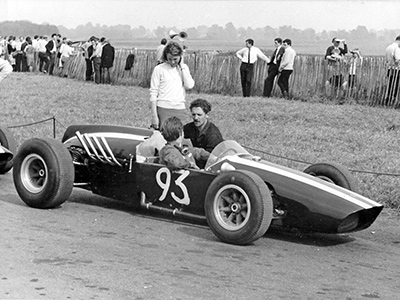
Ian Swift in his Cooper T53-Ford at Castle Combe in July 1965. Copyright Ted Walker 2021. Used with permission.
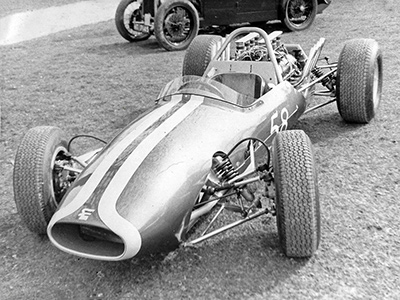
Ian Swift in his Swift-Ford at Prescott in April 1967. Copyright Ted Walker 2021. Used with permission.
Built for 1961 season. Lloyd P Casner's Camoradi International (US/UK) 1961 for Masten Gregory in F1 - Ian Burgess 1961 (last raced late 1962) … advertised from Hampshire May 1963 … To Bill Liddell (UK) for hillclimbs mid/late 1963 with a 1.5-litre Climax and then in 1964 with a 4.7-litre Ford V8. To Ian Swift (UK) 1965 for hill climbs with 4.7-litre Ford V8 and crashed at Dyrham Park late 1965. Rebuilt around new spaceframe chassis as "Swift-Ford" and used to 1969. To Stephen Cuff (Frome, UK) for 1971 for sprints: ran at Tregrehan and Trenwainton early 1971; advertised October 1972 and March 1973. Advertised by another Frome number Sep 1975. To Peter Bloore (Wallingford, Oxfordshire) 1970's - John Harper (UK) about 1990/91 (probably the car advertised from Oxfordshire 1993/94) and rebuilt back to T53 specification - Doug Mockett (US) 1998: retained 2001 and raced in UK historics 2001. Raced by Mockett at the Silverstone Classic in July 2016. Sold by Mockett to Jim Timms, and still owned by him in January 2021.
Driven by: Masten Gregory, Ian Burgess, Ian Swift and Stephen Cuff. First race: BARC Aintree 200, 22 Apr 1961. Total of 44 recorded races.
Built for 1961 season. Yeoman Credit Racing (Reg Parnell Racing) 1961 for John Surtees in Intercontinental Racing and then F1. Presumed car used by Roy Salvadori in New Zealand and Australian Internationals 1962 (but logically more likely to be the Surtees car) and crashed heavily at Warwick Farm. Subsequent history unknown but see the Ken Cox car.
Driven by: John Surtees, Jack Brabham and Roy Salvadori. First race: Lavant Cup, 3 Apr 1961. Total of 8 recorded races.
Built for 1961 season. Bib Stillwell (Australia) 1961 for New Zealand and Australian Internationals and Australian Gold Star racing - Bill Patterson (Australia) 1963 - Don O'Sullivan (Australia) late 1965: crashed at Lakeside 13 Feb 1966. The remains of the car then "formed the basis of his Cooper-Ford sports car with 289ci Ford V8, which was first raced at Caversham 25 Sep 1966. To Bill Downey (Australia) 1967 - Stan Starcevich (Australia) 1968, rebuilt as SS1-11 sports car and reportedly later wrecked in accident. Remains still in Australia 1999.
Driven by: Bib Stillwell, Bill Patterson, Doug Whiteford, John McDonald and Don O'Sullivan. First race: libre race, 17 Sep 1961. Total of 26 recorded races.
Built for 1961 season. Sold to Jack Lewis (Stroud, Gloucestershire) for F1 in 1961. With dealer Ian Raby (Brighton, Sussex) in December 1962, and sold to Lucien Balsiger (Meyrin, Canton of Geneva, Switzerland). It was rebuilt for him by Max Funda with a widened frame and a 3.5-litre Buick engine, and raced by Balsiger in 1963 and early 1964. Sold to Romano Sacchi (Geneva, Switzerland), who raced it at St Ursanne-Les Rangiers and Ollon-Villars in August 1965, and at Urcy in September 1965 where he crashed. The Buick engine was then transferred into the ex-Charles Vögele Brabham BT4 of Gerard Pillon.
The ex-Balsiger Cooper was then rebuilt into a Cooper-Porsche, using the 4-cylinder engine and gearbox from Joe Zuccatti’s ex Heini Walter Porsche 718/RS60 Spyder which had been crashed by Zuccatti at St Ursanne in August 1964. Zuccatti drove this car several times in 1966.
It was then acquired by Serge Bourlier, who had previously owned the Collomb Cooper Special in 1965. He raced the Cooper-Porsche at Marchairuz in late 1966, and then in Swiss and French hillclimbs in 1967 and 1968.
Note that reports of 'R. Savary' driving this car in 1969 are now known to be incorrect.
Driven by: Jack Lewis, Lucien Balsiger, Romano Sacchi and Serge Bourlier. First race: Grand Prix de Pau, 3 Apr 1961. Total of 28 recorded races.
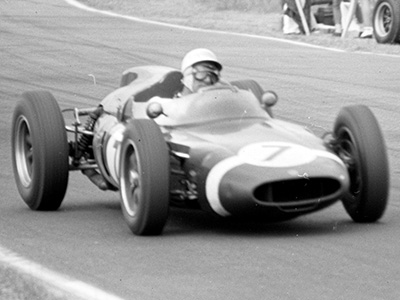
Stirling Moss in his Cooper T53 at Warwick Farm in 1962. Copyright Mitchell Library, State Library of New South Wales. Used with permission.
Built for 1961 season. Rob Walker (UK) 1961 for Stirling Moss in F1 and later in New Zealand and Australian Internationals 1962 - Sandown Park organisers (Australia) 1962 - Frank Gardner (Australia) 1963 for Australian Internationals and crashed at Sandown March 1963. According to John Blanden's research, published in his book "Historic Racing cars in Australia", this car was sold to Stan Jones (Australia) but he insisted it was fully repaired. The car was lodged with Ray Gibbs and according to Blanden repaired on a frame of unknown origin. It is possible that this frame was originally a Yeoman Credit Parnell frame but it is also possible that the suggestion of a replacement frame is a red herring.
This may or may not be the car sold at an auction of Stan Jones' equipment to John Cierpicki. See the Ken Cox car.
John Blanden's book confuses the history of this car with F1-4-61 and assigns the Ken Cox period to both cars. However, he then continues the history of F1-7-61 by saying that it emerged in the Lukey Museum (Australia) some time in the late 1970s - see 'the Lukey Museum car'.
Driven by: Stirling Moss, Jim Clark and Frank Gardner. First race: Lavant Cup, 3 Apr 1961. Total of 7 recorded races.
Built for 1961 season. Terry Bartram (UK) 1961 for Shane Summers in F1. Destroyed in fatal accident in practice prior to Brands race June 1961.
Driven by: Shane Summers. First race: Lombank Trophy, 25 Mar 1961. Total of 5 recorded races.
Built for 1961 season. Bernard Collomb (F) 1961 for F1 and wrecked in accident in practice for Brussels GP 1962.
The surviving rear end of the car was used by Collomb to build a 'bitza' Cooper Special, utilising the front section of a Cooper T45 or T51, the rear of the T53, a 1.5-litre Climax FPF engine and an ERSA gearbox. See 'the Collomb Special'.
Driven by: Bernard Collomb and John Campbell-Jones. First race: Preis von Wien, 16 Apr 1961. Total of 9 recorded races.
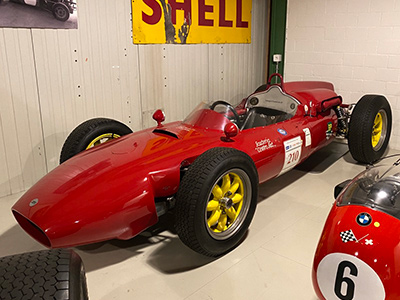
Koni Lutziger's ex-Centro Sud Cooper T53 'F1-13-61' in 2022. Copyright Fabian Lutziger 2022. Used with permission.
Built in May 1961. Sold to Scuderia Centro Sud (Italy) and fitted with a Maserati engine for Lorenzo Bandini in F1 that season. For Bandini again in the New Zealand and Australian Internationals 1962, and again in F1 in 1963. It was unseen from 1964 until it was sold to Jo Siffert (Switzerland) in late 1969 and imported into Switzerland 1970 without engine. From Siffert Collection to Fredy Streun (Berne, Switzerland) about 1975 and restored. To Koni Lutziger (Zürich, Switzerland) 2009. At Ollon-Villars September 2010. Still owned by Koni Lutziger in December 2022.
Driven by: Lorenzo Bandini, Massimo Natali, Mário Araújo de Cabral and Ernesto "Tino" Brambilla. First race: Belgian Grand Prix, 18 Jun 1961. Total of 15 recorded races.
Built for 1961 US GP. John M. Wyatt III (US) 1961 for Roger Penske at US GP and entered by Cooper for Tim Mayer in 1962 US GP. Possibly the car used by Penske in Libre ('Intercontinental') racing in the US in 1962. Subsequent history unknown.
Driven by: Roger Penske and Tim Mayer. First race: United States Grand Prix, 8 Oct 1961. Total of 4 recorded races.
Cooper records show that this car was invoiced to J. R. Sharp in September 1961. Entered for James R "Hap" Sharp (Midland, TX) to drive in the 1961 United States Grand Prix, where it was in works livery and was entered as #3, immediately after the two works cars. Hap Sharp owned two Cooper T53s by this time, the ex-F1 works team spare F2-12-60 that had been used as a spare car at the 1961 Indy 500, and this brand new 1.5-litre F1 car. He sold one of them to Alan Connell for 1962 and kept the other, but it is unclear which one he sold.
See the Alan Connell car and the Hap Sharp 1962-65 car.
Driven by: Hap Sharp. First race: United States Grand Prix, 8 Oct 1961. Only one recorded race.
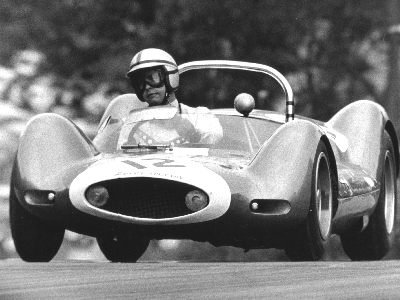
Roger Penske in the Mecom-owned Zerex Special at Brands Hatch in August 1963. Copyright Ted Walker 2005. Used with permission.
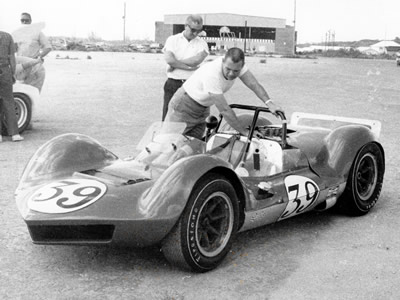
Dave Morgan's Cooper-Oldsmobile, the former Zerex Special, seen here at Nassau in December 1966. Copyright Ted Walker 2018. Used with permission.
Built for 1961 US GP, where photographs suggest that this car was a 'T55' "Slimline" Cooper, rather than the 'T53' "Lowline" designs used for the other customer cars. To Briggs Cunningham (US) 1961 for Walt Hansgen and crashed at US GP. Sold to Roger Penske (US) 1961 and maybe used in libre racing by Penske (see F1-14-61 above) and by Timmy Mayer 1962.
Rebuilt as the Zerex Special late 1962 with 2.75-litre Climax, and Roger Penske won at Riverside, Laguna Seca and Puerto Rica in October and November 1962. At the end of the season, the centre section was cut out, widened, and refitted by Penske's team. In this form it was sold to John Mecom and entered by Mecom Racing Team for Penske to drive in 1963, including the Guards Trophy at Brands Hatch in August, which he won.
Sold to Bruce McLaren for 1964 and raced by him as the Zerex Special at Oulton Park in April, and at the Aintree 200 a week later, which he won. He won again at the International Trophy at Silverstone at the start of May. The car was then extensively rebuilt by the BMMR team with a completely new centre section, and was fitted with a 3.5-litre Traco-Oldsmobile F85 V8. The car was shipped out to Canada for the Players 200 at Mosport Park at the start of June where it was described as a Cooper-Oldsmobile, although the entry list again showed it as a Zerex Special. McLaren won again, against a very strong International field. Returning to England, and with the Traco-Oldsmobile now stretched to 3.9 litres he won again in the Guards Trophy at Brands Hatch in August, but retired from the Goodwood Tourist Trophy after taking pole position.
McLaren's new sports car, the McLaren-Elva Mk 1, was then ready to race, and the former Zerex Special was sold to Dave Morgan in the south-western US in late 1964, and was used by him in SCCA events, as well as the Nassau Speed Week in December 1965 and again in December 1966.
The car was then imported into Venezuela by Leopoldo Roberto Barbosa Bermúdez (Maracaibo, western Venezuela) who raced as Leo Barbosa and whose name was incorrectly given as Leo Barboza in previous versions of this history. Barbosa raced the car across the region in 1967 and 1968, and possibly later. It is believed that Barbosa sold the car to Guillermo Montero (also known as "el Mono" Montero), a race organiser and car dealer who was one of the owners of the Autodromo Internacional La Chinita at Maracaibo. Montero then sold it to Vittorio Coletta, also in Maracaibo, some time around 1980. The car remained in Maracaibo until early 2022 when it was shipped to England and offered for sale om Bonhams' auction at Goodwood on 18 September 2022. It was sold for £800,000.
Driven by: Walt Hansgen and Tim Mayer. First race: United States Grand Prix, 8 Oct 1961. Total of 2 recorded races.

The Cooper T53 in the Honda Collection Hall in November 2023. Licenced by Wikipedia user ‘Liauzh’ under Creative Commons licence Attribution-ShareAlike 3.0 Unported (CC BY-SA 3.0). Original image has been cropped.
Built December 1961 and sold to Okura Trading Company, a Japanese export company that acted as a "front" for Honda's racing activities. Honda's engineers travelled to the UK in 1959 as temporary employees of Okura when the first Honda RC142 motorcycle was entered for the Isle of Man TT.
The ambitious Soichiro Honda then set his sights on Formula 1, and the Cooper T53, the same model that had won the 1960 world championship, was purchased at the end of 1961. This was used as a model for the Honda RA270 F1 prototype, which was designed in 1962 and had its first tests in Arakawa in February 1964, using Honda's innovative 12-cylinder engine. From that car was developed the monocoque RA271, which owed more to the Lotus 25, that made Honda's F1 debut in August that year.
The Cooper T53 has been retained by Honda ever since and is usually on display in the Honda Collection Hall at Motegi, Tochigi, Japan. The Cooper appeared at the Goodwood Festival of Speed in 2000. Still on display in the Honda Collection Hall in November 2023.
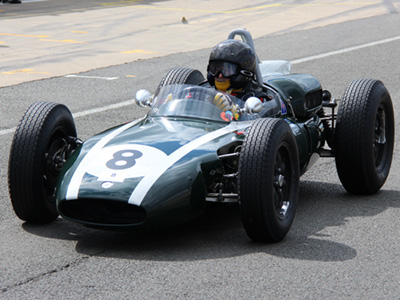
Francois Duret in his Cooper T53 at the VSCC Spring Start at Silverstone in April 2016. Copyright Michael Marsh 2024. Used with permission.
Built by Cooper Cars early in 1963 on a "spare 1960" T53 chassis for John Pringle (Bangor, Northern Ireland): used in hill climbs (with 2.5-litre Climax in 1963 and 2.7-litre in 1964); third at Craigantlet RAC Hill Climb round in 1963 and fourth in 1964; fitted with a Traco-Oldsmobile engine for 1965 and 1966.
To JA Pearce early 1967 - Gary Gove (Federal Way, WA) 1967: converted with Chevrolet V8 engine and Hewland LG600 gearbox for Formula A racing (raced in Continental Championship just once, at R5 Seattle 6 Jul 1969) - Tom Masterson (Great Falls, Montana) 27 Dec 1969: used in SCCA racing until 1973 - Joe Grosso (Castle Creek, NY) 1974: raced once or twice then retired - Paul Kneeland (Alton Bay, NH) 1988 - Eric Jeffries (Cincinnati, Ohio) and Bob Fountain (County Durham, England) 1989: restored by Sid Hoole - Jean-Louis Duret (France) 2001: run in historic racing in UK 2001, at the Geneva/Cologny revival meeting in June 2003, and at the Oulton Park Gold Cup in September 2004. Presumably the car raced by Francois Duret (Narbonne, France) at Pau in 2005. Entered by Francois Duret for the Silverstone Classic in July 2010, and raced at Spa later that year. Raced by Francois Duret at Silverstone in April 2016.
Driven by: John Pringle, Gary Gove and Tom Masterson. First race: libre race, 31 Aug 1963. Total of 21 recorded races.
Unidentified Cooper T53s in 1961
Generations of Cooper scholars - this writer included - have had difficulty identifying how the the two 1960 works cars, F2-5-60 and F2-8-60, were used in 1961. One difficulty in this was that Jack Brabham's private car, F2-17-60, had been conflated with his works car, F2-8-60 in some early histories. The existence of F2-17-60 was known by 2010, but it was only in 2018 that a detailed study of photographs clarified precisely when Brabham drove F2-8-60 and when he drove F2-17-60. By 2019, we knew that F2-8-60 had been raced by Ron Flockhart at Silverstone in May 1961, but not where it went after that. It was only in early 2024, with the emergence of John Coyle's photographs, that it became clear that F2-8-60 was sold to America during September 1962.
By May 1961, when F2-8-60 last raced in F1, the CT 'Tommy' Atkins team was already running a Cooper T53 in Intercontinental and minor F1 races for Bruce McLaren. That car could either be F2-5-60 or could be an all-new new car built at the Atkins workshop. Then later in the season, Arthur Owen used a Cooper T53 in British hillclimbs that initially appeared in works colours and was said in Autosport's 1962 end-of-season review to be an "ex-Tommy Atkins ICF Cooper Climax". We can now be sure neither was F2-8-60, but as the Atkins and Owen cars existed at the same time as each other, there has to be an extra car here. If Autosport was correct, the inference is that the Atkins team used F2-5-60 at the start of the 1961 season, then built a new car to replace it prior to the 1961/62 'Down Under' season, at which point F2-5-60 was sold to Owen. Unfortunately, only a very small number of photographs of Owen's car have been found, so this part of the puzzle remains unsolved.
The CT 'Tommy' Atkins team ran a Cooper T53 for Bruce McLaren in minor F1 and Intercontinental races in 1961. It was driven on its debut by Jack Brabham, who described it as a new car in a post-race interview. McLaren also described it as new in his book 'From the Cockpit', but it is possible that it was built using the frame McLaren's 1960 works car, although there is no direct evidence for this. David McKinney quotes Harry Pearce as saying Atkins never bought a second-hand Cooper in his life. This may be true, but Atkins had acquired an ex-works T51 in 1960, and would borrow the ex-works T55 in 1962, so it is possible he had acquired and updated an ex-works T53 for 1961.
Raced by Brabham to win the IC Lombank Trophy at Snetterton on 25 March, then by McLaren at the seasons other four IC races, as well as the F1 races at Brussels, Solitude, and finally the Oulton Park Gold Cup in September. According to McLaren's book 'From the Cockpit', he then bought the Cooper from Atkins and took it out for the New Zealand Grand Prix in January 1962. McLaren also raced it in the Australian Internationals, during which it was sold to David McKay's Scuderia Veloce, who raced it in the 1962 Australian Gold Star. McKay told David McKinney that he was given the impression the car was brand new. Entered by Scuderia Veloce for Chris Amon in the 1963 Internationals, and for Jim Palmer at two races later in 1963. To Bill Thomasen (New Zealand) in January 1964 in time for the Teretonga International. Raced by Thomasen in minor New Zealand races at the end of that 1963/64 season.
Thomasen bought a Brabham BT4 for 1964/65, and the Cooper went to Johnny Riley, only for him to decide on the ex-Tony Shelly Lotus 18/21 instead. The unwanted Cooper may have gone to Lionel Bulcraig for a while, but by 1968 it was with Feo Stanton, who had formed Rorstan Racing with the support of Tauranga trucking magnate Ian Rorison. It was rebuilt as the Rorstan Sports with 2.7-litre Climax, but remained unraced through the 1967/68 and 1968/69 seasons. In this form to Danie Lupp (NZ) 1969 or 1970, and used in sprints and hillclimbs around 1971 and 1972. Both Vercoe and David McKinney say the car was used by Bob Moore (Whakatane, NZ) with a Vauxhall Victor engine from 1973 to 1977. Sold by Moore to Ted Giles (Dunedin, NZ) in 1978. Giles raced the Rorstan Sports in local club motorsport and historic events such as the Dunedin Festival of Speed and Queenstown Road Races. Still owned by Giles in January 2019, when the car was damaged in a workshop fire.
Driven by: Jack Brabham, Bruce McLaren, David McKay, Greg Cusack, Chris Amon, Jim Palmer and Bill Thomasen. First race: Snetterton, 25 Mar 1961. Total of 26 recorded races.
Arthur Owen (St Helier, Jersey, Channel Islands) raced a 2.2-litre Cooper lowline in hillclimbs and sprints when he returned to competition following his accident at Great Auclum in August 1961. His first event was the Burnham-on-Sea Motor Club's Weston-super-Mare speed trials on 30 September 1961, where he was third, well off the pace of Fred Tuck's Cooper-Maserati, and just pipped for the class win by Jim Berry's ERA. Owen then took BTD and a new record at BARC Firle, near Lewes, Sussex, on 1 October. The following weekend he was at the final round of the RAC Hill Climb championship at Stapleford Airfield near Abridge, Essex, on 8 October where he dominated the event.
It is possible that Owen had acquired this car earlier in 1961, as Mike Kettlewell's review of the 1961 hillclimb season in Autosport (23 Feb 1962 pp273-277) said that Owen "crashed his new Cooper" at Great Auclum. Motor Sport's brief report (Sep 1961 p736) also called it new. That would mean his older car survived, which could explain Owen driving an older-style Cooper at Macau in November 1962.
The identity of this car has long been a mystery. We can now be confident that it was not the ex-Jack Brabham F2-8-60 that Ron Flockhart had crashed at Silverstone in May. It could be the ex-Bruce McLaren F2-5-60 that had last been seen in New Zealand in January 1961 - unless, of course, this latter car had become Tommy Atkins' 1961 car. In Paul Watson's review of the 1962 Hill Climb season (Autosport 22 Feb 1963 pp252-258), Owen's car was described as an "ex-Tommy Atkins ICF Cooper Climax", but only one Atkins lowline is known, and that car went to Australia. It has been suggested that Atkins' team built a new car prior to the September 1961 Oulton Park Gold Cup, selling the older one to Owen, but photographs of the Atkins car during 1961 and 1962 do not support that idea .
Owen fitted a full 2.5-litre Climax engine for 1962, and competed in the full championship. After a slow start to the season, he won at Rest-and-Be-Thankful in June after Tony Marsh crashed the Marsh-BRM on his second class run after setting BTD on his first. Owen took BTD in Marsh's absence at Westbrook Hay a week later. He would also have won at Bouley Bay, had not the RAC reversed their decision to disallow the time of Tico Martini's 650cc kart. Owen was second to Martini at Great Auclum as well, and a series of strong finishes behind the returning Marsh secured the championship for Owen by five points from Ray Fielding's BRM P48.
The Owen Cooper was sold to Scottish husband-and-wife team Gray and Agnes Mickel for 1963, and Gray was third on home ground in the championship round at Bo'ness in June. They retained the car for 1964 and 1965, before replacing it with a newer Cooper T77 for 1966. The lowline was sold in 1966 to wheeler-dealer Fred Tuck (Weston-Super-Mare, Somerset). Subsequent history unknown.
Driven by: Arthur Owen, Agnes Mickel and Gray Mickel. First race: Weston, 30 Sep 1961. Total of 36 recorded races.
The extra Parnell F1 Coopers in 1961
Many of the problems with identification of the Lowline 'T53' Coopers are due to the actions of Reg Parnell's Yeoman Credit team. In 1961, Parnell's team bought three Cooper T53s off the production line, chassis F1-1-61, F1-2-61 and F1-4-61, that appears to have built three more cars during the year. One of these was a T53 chassis with streamlined bodywork and was known as "VR", and a second was built using a Cooper T56 Formula Junior chassis. When the T56-based car appeared at Monza, Denis Jenkinson noted that this brought their team strength to six, two F1s, two ICs and now two specials. His comment proves that there were four standard T53s in the team, so an extra standard car must have been built.
The name 'P2' is given here to that fourth standard T53 used by Yeoman Credit Parnell in 1961. The Formula 1 Register developed the notation 'P1', 'P2', to denote extra cars built by the Parnell team and their notation is used here for "VR" ['P1'] and the extra standard car ['P2'].
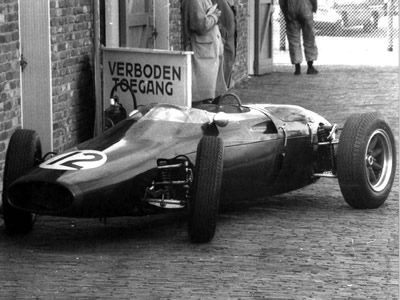
Cooper T53 'VR' in the paddock at the 1961 Dutch GP. Copyright Ted Walker 2001. Used with permission.
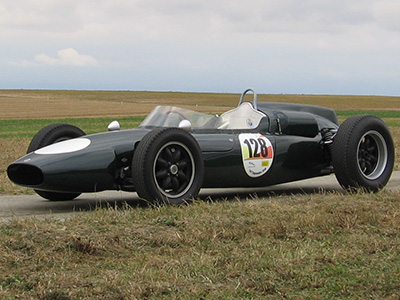
Eric Perrin's Cooper T53 at GP Rétro Curtilles in September 2018. Copyright Eric Perrin 2024. Used with permission.
Built for the 1961 F1 season by Yeoman Credit Racing (Reg Parnell Racing) with streamliner bodywork and known as "VR". First seen at Aintree in April as a spare car for John Surtees, then raced by Surtees at Siracusa. It was only used as a spare car at the next few races, before Surtees raced it in the British GP in July. He also raced it in non-championship F1 races at Karlskoga and Roskilde. Sold to Bernard Collomb (Nice, France) for 1962 and raced at Solitude, the German GP, Karlskoga, Enna-Pergusa and in the Oulton Park Gold Cup, still wearing the VR bodywork. Then sold to Andre Wicky (Lausanne, Switzerland), who raced it in the Pau, Siracusa and Vallelunga F1 races in 1963, again in "VR" form.
Wicky later fitted a 2.8-litre Maserati engine for Swiss hill climbs. It was changed back to Climax power before being sold to Philippe Reitzel (Aigle, Switzerland) in 1967, before returning to Wicky later that year. It was then sold to Jean-Pierre Adatte (Geneva, Switzerland) for hillclimbs in 1968 and 1969. It was later owned by M. Rochat (St Blaise, Switzerland) before being bought by Eric Perrin (Geneva, Switzerland) in October 1979. He initially restored it with the remaining VR bodywork, but as the missing bodywork panels would be difficult to recreate without patterns, he later fitted a standard T53 body. Driven by Eric in the Geneva/Cologny revival meeting June 2003, at the Solitude Revival in July 2013 and July 2015, and at the GP Rétro Curtilles in September 2018.
Driven by: John Surtees, Bernard Collomb, André Wicky, Philippe Reitzel and Jean-Pierre Adatte. First race: Gran Premio di Syracusa, 25 Apr 1961. Total of 17 recorded races.
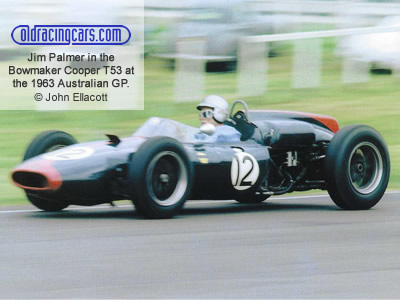
Jim Palmer in the Bowmaker Racing Team's Cooper T53 at the Australian Grand Prix at Warwick Farm in February 1963. Copyright John Ellacott 2020. Used with permission.
Presumed built for 1961 season by Yeoman Credit Parnell. Yeoman Credit Racing (Reg Parnell Racing) 1961 for Roy Salvadori in Intercontinental Racing, possibly using carnet from F1-5-61. Assumed to be the car raced by Surtees in New Zealand and Australian Internationals January/February 1962 (but logically more likely to be the Salvadori car). The ex-Surtees car remained with Parnell during 1962 and returned to New Zealand and Australian at the end of the year when it was the spare Parnell car raced by Jim Palmer in the Internationals in January/February 1963.
Bowmaker/Yeoman Credit had withdrawn from F1 so after the Internationals, Parnell sold off the team's two remaining Coopers to Lex Davison. The ex-Surtees/ex-Palmer car was named in the Australian press as one of the cars Davison bought, but what happened to it next is unknown. It may have been used by Ray Gibbs to rebuild the ex-Moss car that Stan Jones had bought, or it might have been used to rebuild the car that Davison wrecked at Longford in 1962.
Driven by: Roy Salvadori, John Surtees and Jim Palmer. First race: Lavant Cup, 3 Apr 1961. Total of 16 recorded races.
In 1961, Reg Parnell's Yeoman Credit team built a Formula 1 special using a Formula Junior Cooper Mk II 'T56' chassis. This first appeared as a T car at Modena in early September, and was raced by John Surtees at the Flugplatzrennen and the Oulton Park Gold Cup later that month. In December, it was taken to South Africa and was raced by Bruce Johnstone in the Springbok series, but was damaged in practice for the South African Grand Prix. In early 1962, the car was raced by Roy Salvadori at the Grand Prix de Bruxelles and the Goodwood Lombank Trophy, before being relegated to spare car duties. Its last known appearance was as the Reg Parnell Racing entry raced by Mike Parkes in the Mallory Park 2000 Guineas on 11 June 1962.
The fate of this car has not been determined. It now seems unlikely have been the second car bought from Parnell by Lex Davison in early 1963, described at the time simply as a car less engine still in England, as a later Davison advert identified that car as the T58. One possibility is that it was the "ex-Roy Salvadori" Cooper that went to Bryan Eccles in early 1963.
Driven by: John Surtees, Roy Salvadori, Bruce Johnstone and Michael Parkes. First race: Flugplatzrennen, 17 Sep 1961. Total of 7 recorded races.
Unidentified Cooper T53s in 1962
During the first week of January 1962, Parnell's team had two cars at the South Africa Grand Prix: one T53 for Maggs plus the T56 Special for Bruce Johnstone; while another two Parnell team Lowlines were already in New Zealand for the Grand Prix at Ardmore just four days later. But also in that Ardmore paddock were two ex-Parnell Lowlines, one for Lex Davison and a second for Angus Hyslop, the history of whose car was obfuscated due to the need for it to come into the country wearing the same chassis plate as Hyslop's earlier Cooper T45. So that adds up to five Parnell Cooper Lowlines in addition to the T56 Special, while the distinctively rebodied "VR" had presumably stayed in Europe, meaning something does not add up. Could Parnell really have built three extra Cooper lowlines?
Meanwhile there is a problem to be solved with the Cooper T53s in the US as well. Hap Sharp had bought F2-12-60 from Cooper after the 1961 Indy 500 but Cooper records also show him buying a new car, F1-15-61, in time for the US GP. One T53 went to Alan Connell, and it has always been assumed that it was one of Sharp's cars. But which one? Connell and later owners were under the impression his car was the Indy 500 spare car, so F2-12-60, but when Jim Hall donated the other car to the Indy Museum, that one was believed to have been the Indy car. They can't both be right. One possibility is that Sharp never owned F1-15-61 at all, and just bought it on behalf of Connell. In which case, Sharp's car in the 1961 GP was actually F2-12-60, and Connell was mistaken about his car having Indy history. Will we ever get to the bottom of this?
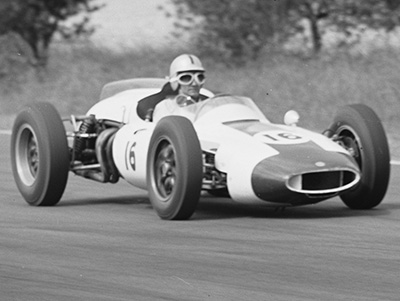
Angus Hyslop in his Cooper T53 at Warwick Farm in 1962. Copyright Mitchell Library, State Library of New South Wales. Used with permission.
In September 1961, the NZIGP Executive Committee approved a loan to local Cooper driver Angus Hyslop to allow him to buy a 2.5-litre Cooper from Yeoman Credit Parnell. However, this story was not known until Kiwi historian Milan Fistonic was given access to NZIGP minutes in 2017, and the story given in 1961 was that Hyslop's Cooper T45 had been "rebuilt" in the UK, emerging as a Lowline Cooper but still wearing the chassis plate from Hyslop's T45. The only clue at the time that it was a Yeoman Credit Parnell car was George Palmer's comment to a young reporter that it had been previously crashed by Salvadori.
The car was raced by Hyslop in the January 1962 International series; the Australian Internationals in Feb-Mar 1962; the 1962/63 New Zealand Gold Star season, which he won easily; and the January 1963 New Zealand Internationals. The Cooper was then sold to Jim Palmer, who had been runner up to Hyslop in the Gold Star, and had raced a Bowmaker Cooper T53 in the 1963 Internationals. Used by Palmer to win the 1963/64 Gold Star, and also raced in the 1964 Internationals. Then to "Red" Dawson for the 1964/65 season, then to Pat McLoughlin for the 1966/67 season. Sold to Charlie Conway (Auckland, NZ) 1986: restored and retained 2011. Displayed at Hampton Downs (NZ) Jan 2011 in the Bruce McLaren Trust marquee.
Driven by: Angus Hyslop, Jim Palmer, "Red" Dawson and Pat McLoughlin. First race: New Zealand Grand Prix, 6 Jan 1962. Total of 23 recorded races.
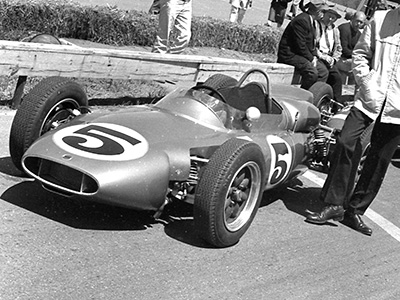
Alan Connell's 'New Blue' Cooper T53 at Hilltop Racing in 1962. Copyright Willem Oosthoek 2024. Used with permission.
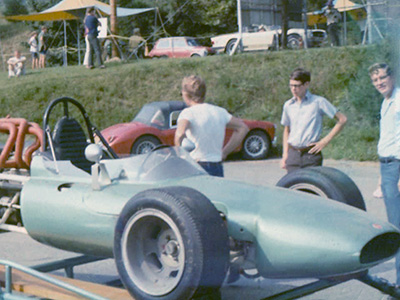
George Miller's Cooper-Chevrolet (place and date unknown). Copyright Bill Miller 2023. Used with permission.
In March 1962, Alan Connell (Fort Worth, TX) announced that he had acquired "a Cooper Formula 1 chassis and body with a 2.5-liter Coventry Climax engine—a formula continental car". Connell called the car "New Blue", a reference to his earlier Birdcage Maserati sports car which he called "Old Blue". Connell raced the car in the Bossier City Intercontinental race on 1 April 1962 and the similar Hoosier Grand Prix at IRP on 29 July. Press reports of the latter race referred to Connell's car as the Cooper used by Jack Brabham at the Indy 500, implying it was the spare T53 F2-12-60 that Hap Sharp had owned. Connell also drove it in the 1962 Mexican GP.
In April 1964, Harry Washburn (Shreveport, LA) entered a car in the new SCCA Formula Libre class at a Divisional race at Green Valley Raceway. The car was described in press reports as "an old Alan Connell 'Intercontinental' car" and "the same 'New Blue' formula car which Alan Connell drove in a few races two years ago". He bought it still with its 2.5-litre Climax engine. Washburn raced the car in an SCCA Regional at Opelousas, LA, winning the Formula Libre class and breaking the track record. He also won an SCCA National at Green Valley Raceway in April, and later won again at Mansfield, LA in a Red River Region event in June. Washburn, a car dealer and regular racer, was elected Governor of the SCCA's Area 7 in 1965, and his Cooper-Climax was mentioned at the time. However, the "Cooper-Chevy" that he raced in 1965 was described as a Cooper-Monaco, not a single-seater. This could be the Cooper Monaco that he had bought from Hap Sharp in August 1962, so references to Washburn in an ex-Hap Sharp Cooper have to be treated with care. When Washburn retired from racing at the end of 1965 he was said to have the sports car and "two smaller cars", one probably his CP Lotus Elan.
At the start of 1966, Leroy Melcher Jr (Houston, TX) announced that he had the "ex-Harry Washburn" Cooper as well as a Lola T70 acquired from John Mecom and a Lotus 30. The Cooper was fitted with a 3-litre Chevrolet II 4-cylinder engine generating 212 bhp. Melcher was not often seen in the Cooper but led the Formula race briefly at the Aqua Festival National at Austin Raceway Park in August 1966 in the "Formula A Cooper" before an oil line broke.
In 1967, Clint Cavin (N Little Rock, AR) raced a Cooper in Formula A. The car had been fitted with a 4-cylinder Chevrolet II engine before Cavin bought it and he understood the car to be ex-Washburn car. However, Clint adds that "I remember hearing or being told that the car was the back-up to that of Jack Brabham's Indy car". When he first entered the car, for the Stuttgart Grand Prix in late April, press reports described it as the car raced by Jack Brabham in the 1961 Indy 500. After an abortive attempt to fit a V8 engine, Cavin traded the car for 1968 to Spurgeon May (Jackson, Mississippi) who raced it in 1968.
The next steps in the cars life are not yet known, but Bill Miller recalls his father George Miller having a Cooper that was said to be the back-up Cooper from the Indy 500. Subsequent history unknown.
Driven by: Alan Connell, Harry Washburn, Leroy Melcher, Clint Cavin and Spurgeon May. First race: Pipeline 200, 1 Apr 1962. Total of 11 recorded races.
Hap Sharp (Midland, TX) owned two Cooper T53s in 1961, the ex-F1 works team spare F2-12-60 that had been used as a spare car at the 1961 Indy 500, and a brand new 1.5-litre F1 car built for the 1961 United States Grand Prix. He sold one of these two cars to Alan Connell for 1962, but it is unclear which one. He retained the other car and repainted it white. He raced it in an Intercontinental Formula race at Indianapolis Raceway Park in July 1962, winning the second heat, and at the 1962 US Grand Prix in October. Sharp and his partner Jim Hall were then absorbed in their Chaparral sports car project over the next few seasons but Sharp demonstrated the Cooper at Road America in June 1964, unofficially breaking the lap record. The car was then back in works livery and was described as a "1960 F-1 Cooper Climax", but wearing Sharp's usual #95. The Cooper-Climax had one further outing in Sharp's hands, winning the Colorado Grand Prix at Continental Divide in May 1965.
Subsequent history unknown, but this car is likely to be the Cooper T53 later donated by Sharp's partner Jim Hall to the Indianapolis Motor Speedway Museum.
Driven by: Hap Sharp. First race: Hoosier Grand Prix, 29 Jul 1962. Total of 3 recorded races.
The Centro Sud Cooper T53
As well as Reg Parnell's Yeoman Credit team and, quite probably, the Tommy Atkins team, a third team constructed a new Cooper T53 outside the factory: the Centro Sud team in Italy. This car was built for a Maserati engine, and was fabricated slightly wider in the centre, to accommodate the slightly larger engine.
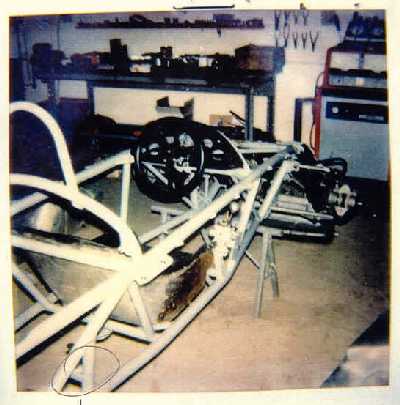
Bob Sutherland's ex-Centro Sud T53 photographed at Alf Francis' workshops in the 1970's. Copyright unknown. Photo supplied by Terry Hefty. Used with permission.
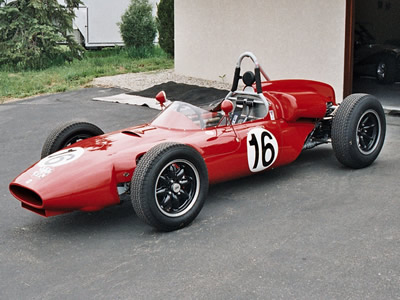
Terry Hefty's Cooper T53 in 2007. Copyright Jeremy Hall 2018. Used with permission.
Mimo Dei's Scuderia Centro Sud had three Cooper-Maseratis in F1 and Intercontinental during 1961: an old unmodified T51, which would have been either F2-12-59 or F2-13-59; an extensively modified T51, probably F2-6-60, with double wishbones and coil springs at the rear; and a new lowline T53 F1-13-61 which was reserved for Lorenzo Bandini to use in F1 . The modified T51 was later wrecked in Johnny Mansell's fatal accident at Dunedin, New Zealand in February 1962. The Centro Sud team did not compete during 1962 due to a dispute with the Italian authorities.
Centro-Sud returned to F1 for the Gran Premio d'Imola in April 1963 with a pair of Cooper-Maseratis and photographs show that both cars appear to be T53s. The Formula 1 Register, in John Thompson's excellent The Formula One Record Book (Leslie Frewin Press 1976) speculated that the Carlo Abate entry was a rebodied T51, but given the differences between the T51 and T53 frames this seems unlikely. It is more likely that Centro Sud had acquired a second T53 frame or had made a copy of F1-13-61. Abate ran the car again at Syracuse four days later, finishing a strong third, and Carlo Peroglio drove at at Vallelunga in May, after which Centro Sud acquired a more recent BRM P578 and a Cooper T60 and the older Cooper-Maseratis were retired. One of these cars went to Jo Siffert (see F1-13-61 above) and the other appears to have been the car acquired in Rome in October 1972 by collector Bob Sutherland (Denver, CO). The car was restored by Alf Francis in the mid-1970s and remained in Sutherland's collection until 1995 when it was sold to Terry Hefty (Lafayette, CO) who has raced it in historic events using a 2.5-litre Climax. This car carries a "F1/12/59" chassis plate with the first "1" appearing to be overstamped. It thus appears to be the second Centro-Sud T53 using the identity of their T51 F2-12-59.
Raced by Hefty in historic racing, such as the 2011 Rolex Monterey Motorsports Reunion, until early 2019 when it was sold to David Smoker (Adelaide, South Australia).
Driven by: Carlo Maria Abate and Carlo Peroglio. First race: Gran Premio di Imola, 21 Apr 1963. Total of 3 recorded races.
Unidentified Cooper T53s and related cars from 1963 to 1969
A considerable number of T53s ran in minor racing later in the 1960s and it has not been possible to work out which was which in all cases. Some, on closer inspection, may turn out to be T51s or earlier cars. The following includes those to have been identified as T53s from photographic evidence or are widely believed to be T53s, but also includes cars that might turn out to have been T55s, the Parnell T56 Special, or even the T58. A Cooper Special built using the remains of a T53 chassis is also included.
The late David McKinney maintained a list of ten probable T53s from the 1960s so more will be added to this list as the photographic evidence becomes available.
For 1963, hillclimber Bryan Eccles (Solihull, Warwickshire) acquired what Autosport described as "the ex-Roy Salvadori/Yeoman Credit Cooper" and fitted a 4.7-litre Chevrolet V8. His first outing was at Prescott in early May, the second round of the RAC championship, and despite only driving it for the first time in Saturday practice, he won the championship runoff. He was quick again in the next round at Wiscombe, but spun at Martini. He was third in class in the "extremely hairy" Cooper at Shelsley in June, but only fifth in the runoffs. He missed the next few rounds, but returned for the August Shelsley National, where he was fastest in the class runds, but broke a CWP and could not start the runoffs. He was next seen winning a SUNBAC hillclimb at Ragley Park on 14 September, but no other results for Eccles in this car are known.
Identification of this car is difficult, as so many of Yeoman Credit's lowline Coopers were wrecked or sold in Australia or New Zealand. It cannot have been the car used by Yeoman Credit Parnell (by then Bowmaker) as a spare in the 1963 New Zealand and Australian Internationals, when it was raced by Kiwi Jim Palmer, as that car was sold to Lex Davison. The ex-works Cooper T58 that Parnell had acquired can be ruled out for the same reason. The first Parnell Special, "VR", had already been sold to Bernard Collomb. John Blanden identified Eccles' car as the Parnell T56 Special, which is more plausible. A photograph of Bryan Eccles' car would be exceedingly helpful in this regard.
It seems likely that this car passed to Alan Eccles for libre racing in 1964 and 1965, if only because Midlanders called Eccles driving Cooper T53s with 4.6-litre Chevrolet V8 engines cannot be common. Alan Eccles wrecked his car in September 1965. See the Alan Eccles car.
According to Blanden, the Bryan Eccles car was crashed and returned to the factory, where it was found and repaired by Ray Gibbs, who then shipped it to Australia around 1965. See the Bob Punch car.
Driven by: Bryan Eccles. First race: RAC British Hill Climb Championship Round, 5 May 1963. Total of 5 recorded races.
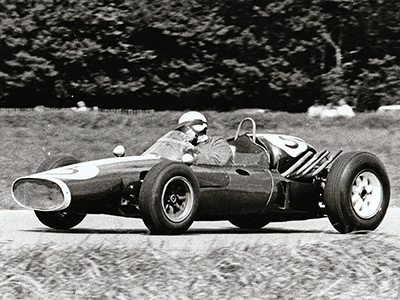
Alan Eccles in his 4640cc Cooper-Chevrolet at Castle Combe on 31 July 1965. Copyright Ted Walker 2010. Used with permission.
Alan Eccles, proprietor of Hilltop Garage in West Bromwich, Staffordshire, had raced a Cooper in libre racing in 1962, 1963 and 1964, a car described by Motoring News as an "old leaf spring 2-litre Cooper-Climax" and "previously one of Jack Brabham's mounts". In May 1964, he appeared with a Chevrolet-engined Cooper, and photographs show that it was a lowline Cooper. The late David McKinney believed this was the same car that Bryan Eccles (Solihull, Warwickshire) had raced in hillclimbs in 1963, but that may have been an assumption based on the belief the two were related. Eccles won a number of races in the car, but at Silverstone on 11 September 1965, he crashed, went into ditch and cartwheeled. The car was, according to Autosport, written off.
The origins of this car are unknown, but it is possible that this was Bryan Eccles' 1963 car. It is also possible that the car then went to Australia (see the Bob Punch car), but John Blanden reports that Punch bought the car in Melbourne on 25 September 1965, just two weeks after Alan Eccles accident at Silverstone, which makes this link highly improbable.
Driven by: Alan Eccles. First race: Nottingham Sports Car Club (NSCC) Formule Libre race, 3 Aug 1964. Total of 11 recorded races.
Bernard Collomb, a garage owner from Nice in the south of France, acquired a new Cooper T53 for the 1961 season, but the car was destroyed by fire at the Grand Prix de Bruxelles in early 1962. Collomb then built up a Cooper Special, using the rear end of the T53 and the front end of an older T45 or T51, presumably the T45 that Collomb had raced in 1959 and 1960. This Special was sold to Serge Bourlier (Geneva, Switzerland) in 1963 or 1964 who used it in Swiss and French hillclimbs, sprints and slaloms in 1964 and 1965. It was also raced during this time by Swiss driver André Wicky at Payrner in 165 and by R Savary in early 1966. Later in 1966, the car was sold to Michel Renaud (Ollon), and was raced by him with a 1500cc Climax engine. At the Bergrennen St. Antoni-Obermonten in April 1967, he crashed the car heavily, and rebuilt it with a home-made rear end, severing its last remaining link to Collomb's T53. Renaud continued to race it in this modified form until the end of 1968. He then used the engine, gearbox and suspension parts from the Collomb Cooper to build a new car, using a chassis that was a copy of a Brabham BT21B. He raced this for two more years. He then advertised his car as a "Climax" in 1971, and sold it to another Swiss owner. The chassis of the Collomb Special, still with its T45/51 front end and home-made rear end, together with some of its bodywork, were offered for sale from Ollon in April 1990, and sold to England. The car changed hands again in 1992, and then remained in storage in England for many years.
Driven by: Serge Bourlier and Michel Renaud. First race: Swiss Championship Round, 3 Oct 1965. Total of 7 recorded races.
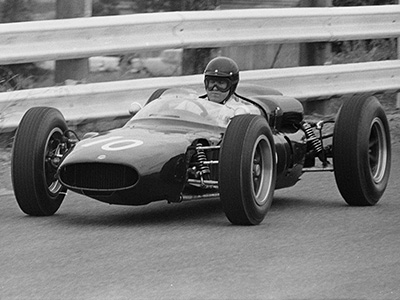
Don O'Sullivan in his second Cooper at Sandown Park on 27 February 1966. Copyright Mitchell Library, State Library of New South Wales. Used with permission.
After Don O'Sullivan wrecked his Cooper T53 F1-5-61 at Warwick Farm in February 1966, he was back out just two weeks later in what appears to have been a completely different car. His new car was shaped like a 1961 T55 or T58, not a 1960 T53, and photographs of it appear to show features unique to the Cooper T58. After retiring on his debut in the car at the Sandown Park Cup, he took it back to Western Australia and raced it at Caversham later in 1966 and in early 1967. O'Sullivan then bought a Cooper T70, and this older car was raced by mechanic Jaime Gard later in 1967. Subsequent history unknown.
Driven by: Don O'Sullivan, Bill Downey and Jaime Gard. First race: Sandown Park Cup, 27 Feb 1966. Total of 10 recorded races.
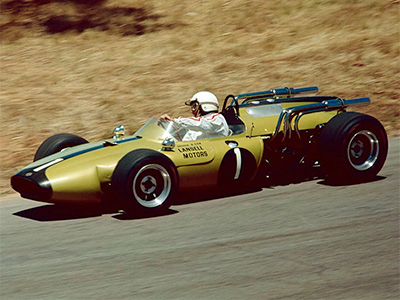
Ken Cox in the Cooper T53 with Ford V8 engine at Hume Weir in late December 1968. Copyright Richard Simpson 2024. Used with permission.
First certain history is when acquired by John Cierpicki from an auction of Stan Jones equipment in 1966. Long-time owner Alan Banister believed it to be F1-4-61 based on a physical inspection of the car but the ownership history points to it being F1-7-61.
According to a Ray Bell story on this car published in Motor Racing Australia in 2001, the Cooper was acquired by Cierpicki less engine and was understood to be "the car that Roy Salvadori had raced". It was rebuilt with one of the new 179 ci (2930cc) seven-bearing Holden 'red' engines which had been built up by Kerry Luckins at Paul England’s workshop. The car was driven by Cierpicki's regular driver Ken Cox (Benalla, Victoria, Australia) in libre racing but suffered many blowups over the next few seasons. The last of these blow-ups, which proved effectively fatal to the engine, came around February 1968.
In December 1968, Ken Cox appeared at a meeting at Winton having "done a beautiful job of slotting a 289 [ci Ford] V8 into into the Cooper chassis". He was entered as before by John Cierpicki and won the 4-lap opener before retiring from the feature race. Cox raced the Cooper Ford V8 again in a race at Hume Weir in Nov 1969 and at Winton a month later, typically entered by 'J Cierpicki'. Early in 1970, the car was driven at least once by Bob Minogue (Melbourne, Australia), still with its Ford V8. In August 1970, Cox advertised the car, saying it was "ex-John Surtees" and now had a 330 bhp 302 ci Ford and a 5-speed Colotti 'box. Minogue then bought the car, and raced it at Amaroo Park in August 1971, having moved from Victoria, and he then advertised it in October 1971 as an "ex-J. Surtees 1962 lowline" with 302 ci Ford. The car was later sold to Des Lascelles who drove it in a F5000 race at Warwick Farm in Sep 1972.
The car is said by John Blanden to have gone to George Johnson who sold it to Alan Banister (Sydney, Australia) in Oct 1978. Banister retained the car until his death in 2014. The car was still with his family in January 2018.
Driven by: Ken Cox, Bob Minogue and Des Lascelles. First race: Racing Scratch, 4 Dec 1966. Total of 16 recorded races.
The first certain history for this car is when it was imported to Australia by Ray Gibbs about 1966, at which time it was equipped with a Chevrolet V8. According to the late John Blanden's "Historic Racing cars in Australia", this car had been the Yeoman Credit Parnell Cooper T56 F1 Special in 1961 and early 1962, and then had become the Bryan Eccles hillclimb car in 1963. Blanden then refers to it being in an accident, which is consistent with Alan Eccles crashing a Cooper-Chevrolet in 1965. Ray Gibbs is said to have found it when it was returned to the factory, acquired it and repaired it. He then imported it to Australia. Blanden inspected the car not long after it arrived and believed it to be a 1961 or 1962 lowline, noting that it carried chassis plate "F2-30-57".
Blanden says that it was bought by Bob Punch (Melbourne) on 25 September 1965 but this date is too early if it was Alan Eccles' car, as Eccles accident was only two weeks before this, and Eccles car looks like a T53, whereas Blanden described this Gibbs-Punch car as the ex-Parnell T56 Special. Punch's Port Phillip Motors (Hampton, Victoria) advertised the car in Racing Car News Oct 1967 as a "Lowline Cooper 1963", "ex-Yeoman Credit car" less engine having "done 1 season only". Entered by Port Phillip Motors for Punch with a Holden engine in 1968 and then a Ford Falcon engine in 1969. The car was advertised with a Falcon engine by Punch from Melbourne in Feb 1970 as 'Victoria's top libre car'.
According to Rob Saward, it was then sold to Vic Butler in Tasmania who continued to race it with Falcon engine, making his debut in it at Baskerville in September 1970. It was then sold to Mick Cooper (Franklin, Tasmania) who replaced the Falcon 6 with a 1600cc Datsun engine for 1972 and was a regular entry at Baskerville and Symmons Plain from 1972 to 1976. By the end of 1973, the impressively competitive car had Brabham running gear and radically different bodywork, but retained its 5-speed Colotti gearbox. Cooper advertised the car in Racing car News in February 1974, but evidently didn't sell it at that time. Robin White reports that he bought the car from Mick Cooper, and raced it in Tasmania in 1977.
Then, according to Blanden again, it was advertised in 1977 and acquired once again by Ray Gibbs. He restored it to the appearance of the 1961 Yeoman Credit Parnell T56 F1 Special and it appeared at Sandown Park in 1987 in this specification. Gibbs continued to use it in historic events until 1999 when it was offered for sale by Shannon's. Due to problems getting a CAMS log book, the car was sold to John Harper in the UK in 2001 where it was able to get what Blanden describes as "full FIA papers". The recent history of the car is unclear but it is believed to be the "F1 T56" being raced by Trevor Needham in 2010. Needham's car sold in August 2012 to John Evans, who ran it at Monaco in 2014 as the Yeoman Credit Parnell T56. Sold to John Clark (Aberdeen, Scotland) in 2015, and raced at Monaco in 2016, at Phillip Island in 2017, and in HGPCA racing in the UK in 2017.
Driven by: Bob Punch, Vic Butler and Mick Cooper. First race: Racing Scratch, 15 Apr 1968. Total of 13 recorded races.
In Ray Langdon (Jersey, UK) bought a Cooper "Intercontinental" from JA Pearce Engineering, who had converted it to use a 4.7-litre Cobra Ford V8, which involved lengthening the frame. Pearce told Langdon that the car had been in the team's transporter with its F1 car when the transporter caught fire, and although the Cooper had been rescued, the F1 car was consumed. This would be a reference to the team's catastrophic transporter fire at the Silverstone International Trophy in April 1967.
Langdon recalls that he took the hill record at Bouley Bay on his first run, despite the car lacking a first gear. He raced it in hillclimbs and beach racing for at least three seasons, and was second at the Guernsey hillclimb at Val des Terres August Bank Holiday Monday 1968. Langdon then retired from racing, and sold the Cooper to Alan Dix. Dix fitted the missing first gear, and promptly broke Langdon's hill record. Dix later sold it to someone on Guernsey. Subsequent history still being resolved.
Driven by: Ray Langdon and Alan Dix. First race: RAC British Hill Climb Championship Round, 20 Jul 1967. Total of 4 recorded races.
Unidentified Cooper T53s from 1970 onwards
By the end of the 1960s, almost all the original T53s had faded from sight. Historic racing was growing by this stage, led by the Vintage Sports Car Club in the UK which arranged races from the mid-1960s onwards for front-engined cars from the Maserati 250F era. By the middle of the 1970s, attention was turning to newer cars, with the Historic Sports Car Club (HSCC) catering for rear-engined F1 cars. An HSCC series sponsored by Lloyds & Scottish in 1979 gave a higher profile to these races, and Cooper T53s started to increase in value. The Historic Grand Prix Cars Association (HGPCA) was formed in 1979, and that club eventually became the main home of cars from this era.
As this form of racing grew through the 1980s, the difficulty was finding these old cars, as many had not been seen since the late 1960s and quite a few had their careers terminated by accidents. John Coetzer had "wiped out" F1-1-61 in South Africa, Roy Salvadori had wrecked F1-4-61 in Australia, Stan Starcevich had wrecked F1-5-61 in Australia, somebody had reportedly wrecked F1-6-61 in Switzerland, Shane Summers had destroyed F1-8-61, and Bernard Collomb had wrecked F1-9-61. With nobody in the 1960s having any reason to believe car values would escalate so sharply in the 1980s, many of these cars were parted out and only a few components survived. John Harper was very active tracking down those remains, and through his efforts a number of cars were reconstructed, often with replacement chassis frames. However, there are still gaps in many of the cars' lives.
The list below is a mixture of cars where we do not have enough evidence to reliably connect them to an original entity. In some cases they comprise new chassis frames and new bodies, plus an indeterminate number of components in them that are said to have come from original cars. Unfortunately, in some cases the provenance of the components has not been determined with sufficient confidence. In other cases, the cars appear genuine, but it is unclear which car they are.
Any new evidence about these cars would be most welcome.
Bought by John Harper at a bankruptcy sale in the Nottingham area in the mid-1970's. It appeared to be an early 1960s Cooper and may have been a T53, but the ravages of time made it impossible to be sure. It came with a Colotti Type 21 gearbox. Rebuilt by Harper to T53 specification. Via Tony Mantle (UK) to Mike Gue (UK) late 1970's. Gue emigrated to US and car's subsequent history unclear.
This is thought to be the Griswold car.
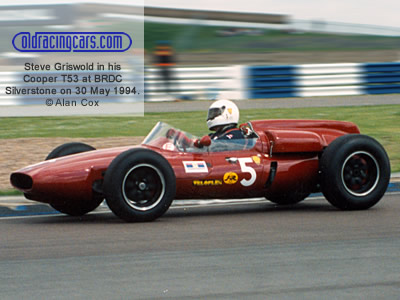
Steve Griswold in his Cooper T53 at BRDC Silverstone on 30 May 1994. Copyright Alan Cox 2020. Used with permission.
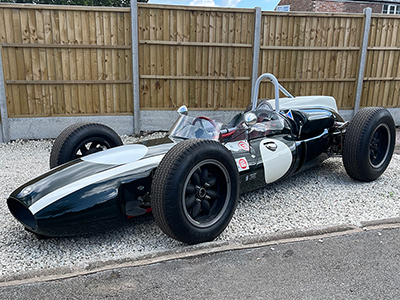
Tony Lees' Cooper T53 in July 2021. Copyright Tony Lees 2023. Used with permission.
First seen with Jim McAllister, a director of Ferrari dealers Grand Prix SSR (East Setauket, NY) 1977. To Steve Griswold (San Francisco, CA), who recalls that it had a Colotti gearbox, and taken to Sid Hoole in England for restoration. Raced by Griswold in the US (dates unknown) and then in Europe 1987/91, and again after a break 1994/95. Later with Steve O'Rourke 1996/97 (and Tim Sugden) and then John Coombs (raced by Frank Sytner, Stirling Moss and Jack Brabham). Entered by Coombs for Gary Pearson to race at the 2004 Goodwood Revival.
According to David McKinney, this car next appeared at the 2010 Goodwood Revival, where it was raced by Alistair McCaig. Raced by McCaig again in 2011 and 2012. Entered by 2013 Stuart Hughes for Jonathan Hughes to drive at the VSCC Silverstone Spring Start in April 2013. Next seen when acquired by Chris Drake in early 2015 and raced by him for the first time at the Donington Historic Festival in May 2015. Later raced by Drake at the Silverstone Classic in 2018 and 2019.
In September 2020, Drake sold the Cooper to Tony Lees in Leicestershire, who has continued to race it with the HGPCA. Still with Lees in February 2024.
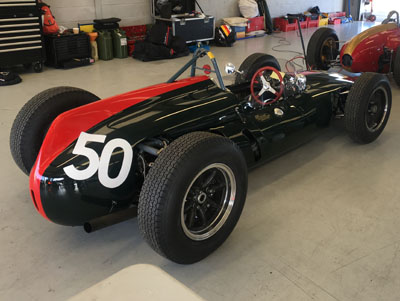
Wulf Goetze's Cooper T53 at the VSCC Spring Start at Silverstone in 2019. Copyright Wulf Goetze 2019. Used with permission.
The remains of F1-1-61 were reportedly located by Ivan Glasby in South Africa, and exported by him to Sydney, Australia. Ivan was the son of Rhodesian racing driver Eric Glasby, and the family moved to Australia in 1981. The Cooper remains were sold to John Harper (UK) in February 1995, who reported that they only consisted of corners and other parts, what was left of the original frame being scrapped by Glasby and Harper in Sydney. Harper built a new frame in England, and the car was complete by March 1999. To Ted Rollason (UK) 2001, and raced by him in 2001 and 2002. Bought from Rollason by Wulf Goetze (Köln, Germany) in 2014 and raced after an intensive overhaul. Raced by Goetze through the 2019 HGPCA season, but not seen in 2020 or 2021.
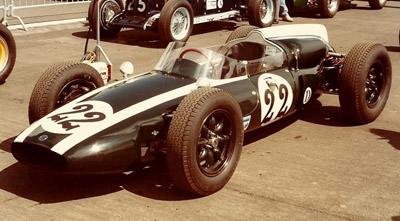
John Casado's Cooper T53 on the grid for the Pre-65 race at the 1985 British Grand Prix. Copyright Ben Cowdrey 2020. Used with permission.

Don Schoney's Cooper T53 in 2006. Copyright Jeremy Hall 2006. Used with permission.
First reference with Roger Sweet (UK) early 1980's - Stephen Griswold (Berkeley, CA) 1982 - John Casado (Los Angeles, CA) 1983: raced in UK then taken to US in 1986 to race at Sears Point and the Monterey Historics - James Stollenwerck (Beverly Hills, CA) 1987 - Tom Byrnes (Ross, CA) 1992 (or 1990?) - Don Schoeny (Princeton, MA) 1997. Raced by Schoeny at various events, including Monterey Historics, Sears Point, Watkins Glen and Lime Rock. Entered for the 2006 Monterey Historics but with no chassis number given.
Bought from Schoeny by Jeff Abramson (Danville, CA) in 2007. At the time it was said to be the ex-Arthur Owen car, and the early history given to Abramson was Owen 1961-1969, John Harper 1969-1975, Roger Sweet 1975-1982, and then to Griswold in 1982. It should be noted that this does not agree with the known history of the Owen car going to Gray and Agnes Mickel in Scotland 1963, and them selling it to Fred Tuck in 1966. The car did not have a chassis plate but was inspected for Abramson by Steve Froines.
Raced by Abramson in the Wine Country Classic in June 2008. Raced by Abramson at Monterey in 2010, at CSRG events in 2012, and at the Sonoma Historic Festival in 2014. In 2020, it was advertised as being the ex-Arthur Owen car, having then gone via John Harper to Roger Sweet. Bought from Abramson via Mark Leonard's Grand Prix Classics in September 2020 by Mark Gillies (Round Hull, Virginia), who planned to race it with the HGPCA in the UK.
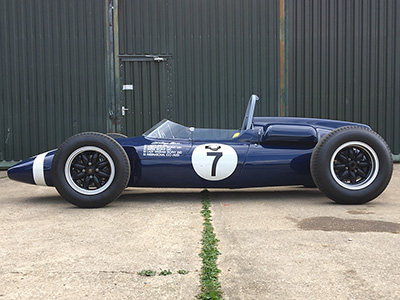
The ex-Lukey Museum Cooper T53 of Nick Topliss in July 2018. Copyright Nick Topliss 2018. Used with permission.
According to John Blanden's book 'Historic Racing Cars in Australia', a Cooper T53 "appeared at the Lukey Museum at Phillip Island race circuit". Blanden lists this car under the heading of the ex-Stirling Moss F1-7-61, but the previous history he gives for the car as being ex-Ken Cox and ex-Bob Minogue duplicates history given five pages earlier in the book under the heading of F1-4-61. Other sources say that the Lukey Museum car was bought from Ray Gibbs, and had come to him from Don Fraser. Gibbs had bought a T53 from Fraser, but that was F1-2-61, which Gibbs later passed to Tony Osborne. However, Gibbs had also acquired the ex-Moss car after Frank Gardner's crash in it at Sandown in 1963, so it is possible that he had retained it, and that the car sold at the Stan Jones auction in 1966 was a different T53.
According to current owner Nick Topliss, the car was sold by Gibbs to the Lukey Museum in 1969. It appeared in a 1980 museum brochure where it was credited to Gibbs abd on display in Moss's livery. The Cooper was sold in 1986 to American collector Art Valdez (Torrance, CA), who had it restored in Australia by Keith Sparks. It made its first appearance at Sandown Park in March 1987, now in Rob Walker livery. It was later shipped to the US and remained in Valdez' collection until 2017, when it was sold to a UK consortium. Sold in November 2017 to Nick Topliss (Woodstock, Oxfordshire). Raced by Topliss at VSCC Silverstone in April 2019, the HGPCA Pre-66 race at Silverstone in August 2021, and the Oulton Park Gold Cup in July 2023.
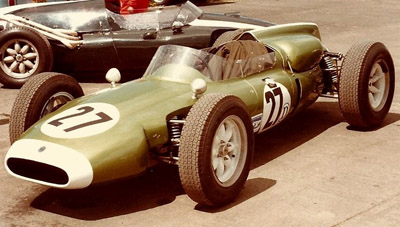
John Harper's Cooper T53 on the grid for the Pre-65 race at the 1985 British Grand Prix. Copyright Ben Cowdrey 2020. Used with permission.
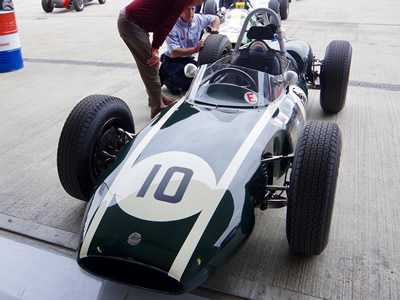
Georgio Marchi's Cooper T53 at the Silverstone Classic in 2017. Licenced by David Merrett under Creative Commons licence Attribution 2.0 Generic (CC BY 2.0). Original image has been cropped.
A car built to 1960 specification by John Harper (UK) in the early 1980s based on remains found in Jersey and said to be "ex-Arthur Owen". Harper's car is claimed to be chassis F2-5-60, Bruce McLaren's 1960 car, which Harper believed to have then been Owen's 1961-62 hillclimb car.
Harper raced this car in historic racing from 1988 to 1991. To car dealer Gerry Porter (Kensington, London) 1991, and raced from 1992 to 1996, when it was crashed testing. Returned to competition in 1998. To Spencer Flack (Chorleywood, Hertfordshire) 1999, then to Barry Cannell (Doncaster, South Yorkshire) 2001 and raced in UK historics 2001 to 2006. To Georgio Marchi (Italy) May 2007 and raced for him by Enrico Spaggiari from 2008-2011 and then by William Nuthall from 2012 to 2014. Still being raced by Nuthall in 2021.
According to a 2007 H&H Auction catalogue, after O'Sullivan's 1966 accident, some parts from the Cooper were "salvaged by Bam Siczillan of Sydney, Australia". This name has also been reported as "Sam Siczman" but neither surname can be found in Australia. These components were later sold to Barry Brown (Pacific Palisades, CA) and then "incorporated into a restored version of 'F1-5-61'" using other components supplied by Sid Hoole between 1987 and 1989. Entered by Barry Brown at Monterey in 1994. Entered for the Brooks Goodwood sale in 2001. The car was given a HVIF in 2001 and won a HGPCA event at Dijon that year in the hands of John Harper. Offered for sale by H&H's auction at Kempton Park Racecourse in July 2007, having not raced since Dijon, but it did not sell. Subsequent history unknown.
Believed to be the car raced by Mark Piercy in the HGPCA Pre 1966 race at the Silverstone Classic 2008. Raced by Piercy at Brands Hatch in May 2009, and Spa in September 2011. Next seen when raced by Rainer Ott at Dijon 2013, Dijon 2014, Montjuïc April 2015, Brands Hatch May 2015, Brands Hatch July 2016 and Goodwood March 2017.

Allan Miles' Cooper T53 at the Coys Festival at Silverstone in July 1999. Copyright Dave Williams 2022. Used with permission.
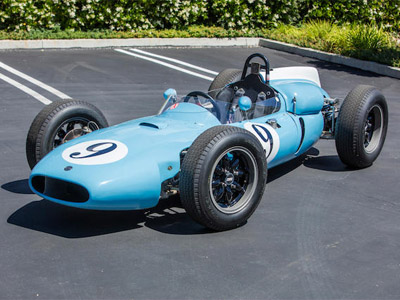
The "ex-Bernard Collomb" Cooper T53 as auctioned by Bonhams at Quail Lodge in 2019. Copyright Bonhams 2019. Used with permission.
Some parts acquired from Switzerland or southern France by John Harper (Kineton, Warwickshire) in the late 1970s. The parts were sold to Allan Miles (Tonbridge, Kent), who ran South Coast Historic Racing with partner Gerry Hann (Brockenhurst, Hampshire). Miles constructed a Cooper T53, initially using Rob Walker''s colour scheme, and raced it in HSCC events in 1988. He continued to race the car until 1999. To Ted Williams (Bristol) 2000, and raced in 2000 and 2001.
Sold to Rodolfo Junco (Redondo Beach, CA), and maintained for him by Steve Tillack. Raced by Junco at the Monterey Historic Automobile Races in California in 2003 and by Tillack in 2006, by which time it had been repainted in a pale blue colour. Reportedly sold to motorcycle collector Mike Taggart (Ojai, CA) some time before 2010. It was offered for sale by Bonhams at Quail Lodge in 2019. Then via car dealer Josh Cohen (Santa Barbera, CA) to David Woodhouse (La Jolla, CA) later in 2019. By 2022, Woodhouse had repainted the car in Cooper works colours.
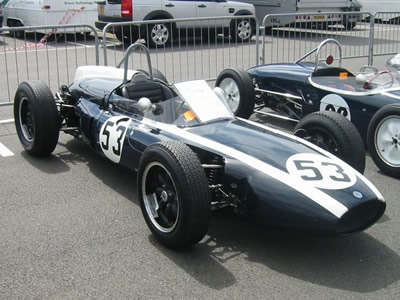
Chris Bullimore's Cooper T53 at Silverstone in July 2006. Copyright Allen Brown 2006. Used with permission.
According to its 1991 HVIF, this car went from Hap Sharp to Harry Washburn and then to Melcher Racing in 1967. The papers do not mention either Cavin or May.
The next name on the papers after Melcher Racing is that of Dick Weyer (Cincinnati, OH) then it went to Chris Briston in 1974, Ivan {illegible} in Australia in 1987 and then Martin Eyears in 1989. Chris Briston, an Englishman based in the US for many years, was in contact with Stephen Dalton in 2012 and told him that he'd exported five Coopers to Australia in the early 1980s. One of these was F1-15-61 and went to Ivan Glasby; the others went to John Caffyn and Robert Kirkby. Briston recalled that he "bought it from a guy in Cincinnati who had a 4 cylinder Chevrolet Midget racing car engine in it". The 4-cyl Chevy is a very solid link the car owned by Clint Cavin and Spurgeon May.
The T53 was reportedly at a Coys auction in 1993 and the new owner was Christopher Bullimore (UK) 2001. Bullimore sold the car to Joe Fairley (Belfast, N. Ireland) in early 2007 and it has been raced by his nephew Jon Fairley (Huddersfield, UK). Retained 2012.
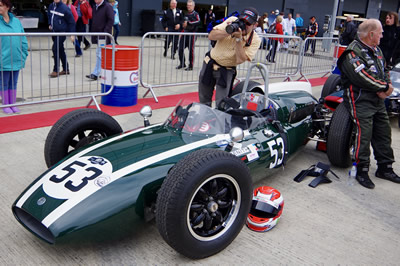
Scotty Taylor waits with his Cooper T53 at the 2017 Silverstone Classic. Licenced by David Merrett under Creative Commons licence Attribution 2.0 Generic (CC BY 2.0). Original image has been cropped.
Built by Peter Bruin of Goodwood Engineering (Auckland, New Zealand) in the early 1980's using a replica frame and (reputedly) some of the bits left over when the former CT Atkins car was rebuilt into the Rorstan Sports in 1967 or 1968. According to a later Bonhams auction description, Bruin acquired "the remaining complete body, the fuel tanks, wishbones, exhaust system, Cooper gearbox remains and wheels". This project then passed to Bill Clark (NZ), who completed it with many new components, and a 2.7-litre Climax engine. The "body paneling, fuel tanks, wheels etc" were said to be original in the completed car.
The car was little used from completion until it was offered at auction by Bonhams at their Goodwood sale in September 2006, where it was bought by Scotty Taylor (Australia). Sold by Taylor to Justin Maeers (Great Oxendon, Northamptonshire) in September 2018. Raced by Maeers in HGPCA events in 2019 and 2021.
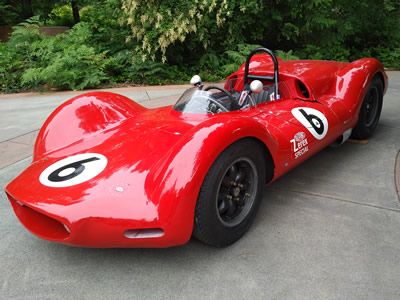
Greg Heacock's Zerex Special reconstruction in June 2018. Copyright Greg Heacock 2018. Used with permission.
A reconstruction of the Zerex Special, in the form Roger Penske first raced it, has been built in the Seattle area by Greg Heacock (Maple Valley, WA). This car is claimed to be based on components of the Zerex Special left over following its extensive rebuild by Bruce McLaren's team in 1964, including the whole centre section of the car which McLaren replaced. Heacock has advised the author that "I have the components from the cars entire life pre McLaren", and that "I purchased the McLaren discarded T53 frame and matched that with the ‘centre seat’ T53 components I acquired from the mechanics: Roy Gane, Harry Tidmarsh and Jock Ross". Heacock says that the car "was reconstructed around a T53 frame I purchased from Steve Froines".
Whether this car is indeed a reconstruction built using surviving component of the original Zerex Special, or whether it is actually a replica with no connection to the original car, was the subject of a heated dispute in 2005, when the project to recreate it was first mentioned, and again during 2019 after the finished car appeared. Heacock's claims were reproduced in an article in Motor Sport in August 2019, but the article was widely criticised and the claims were disputed, notably by Philippe de Lespinay, who gave a detailed response to the article on Motor Sport's website on 2 August 2019. At the time of writing, the magazine has made no response to his posting. Autosport then repeated the owner's claims in an article by Paul Lawrence on 12 September 2019, in which he said that the centre section had been bought by Heacock at the Beaulieu Autojumble in 1999.
The main criticism made by de Lespinay is that the ‘centre section’, photographs of which were posted in 2013, is not actually part of the Zerex Special, and that other components used were also not part of that car. Philippe has correspondence from one of McLaren's 1964 crew to support his argument that "The pieces of tubing cut from the chassis were binned and when sawed off, none were attached to any other, so no one would have ever known what they were from".
The finished car was raced by Heacock at SOVREN's Spring Sprints at Pacific Raceway in April 2018. In 2019, it came to England for the Goodwood Revival meeting, which was the trigger for the Motor Sport article.

Barrie Read's Cooper at the Rob Roy hillclimb in November 2021. Copyright Barrie Read 2022. Used with permission.
When Shannons auctioned the Len Lukey Museum Cooper T53 on behalf of the Gibbs family in July 2018, a second T53 was also included in the sale. Very little information was provided about the car, but Shannons commented on its "uncertain chassis origin" and that "its history is unclear". It was observed to be wearing a chassis plate "F2-5-60", but absolutely no evidence was presented to show any link to that car. One observer who inspected the car commented that its chassis frame appeared to be new. The car was bought for $76,000 by an owner in Melbourne, Australia. It was run for the first time at Winton in November 2020, and was advertised in the August 2021 VHRR Newsletter by Barrie Read (Park Orchards, Melbourne) for $140,000. Still with Read in January 2022. By mid-2024, the car had been acquired by Tim Ross in the UK.
Other cars of relevance
There are other cars that have a relevance to the Cooper T53 story, either because they were thought to be T53s at some point, or because they were very similar cars. These include:
The Cooper T54 Indy car. The Cooper T54 was very similar in appearance to the T53. After its final Indy 500 appearance in 1963, it was sold off the SCCA Formula A and was owned by Don Radbruch (Palo Alto, CA), Dick Terrell (San Bruno, CA), Bob McLease (Seattle, WA) and Tony Soleski (Tacoma, WA) over the next ten years. For the full story, see the Cooper T54 page.
George Alderman (Wilmington, Delaware) raced a Cooper with a 1500cc Alfa Romeo engine in SCCA events from July 1962 up to early 1965. As photographs showed a Lowline of some sort, it was unclear whether he had a T53 or a T56. Thanks to local press articles made available on newspapers.com, it is now possible to be certain that this was a Formula Junior car, converted from Ford to Alfa power in mid-1962.
Graham Eden appeared at a few libre races in England in 1963 with a Cooper with 1475cc AJB Arden engine. This car was thought to be a Cooper T53, but a photograph shows that it had the narrower bodywork and smaller fuel tanks of a Formula Junior Cooper T56. Cooper T53 owner Flavio Puccinelli spotted the key detail: on a T53, the frame has curved tubes under the gearbox for clearance of the larger C5S gearbox, whereas Eden's car has straight tubes.
Frank Dochnal (actually Frank J. Dochnal) drove a Cooper T51 at the 1963 Mexican GP meeting but crashed in practice and did not start. For a long time, this car was a complete unknown and was listed in some sources as a T53. However, an interview conducted with Dochnal by the now defunct F1 Rejects website in 2003 clarified that his car was a T51. An advert on Motorsports Market (retrieved 20 May 2008) gives the identity F2-23-59 as Dochnal's car. From Dochnal, it went to Ed Mackay (Camarillo, CA) 1964 - Ivan Zaremba (Berkeley, CA) Dec 1966 - Ron Fink (Crockett, CA) early 1970. Acquired from Fink by Steve Froines (Dublin, CA) early 1970s, restored, raced extensively and retained until 2005. In 2007, this car was raced at Monterey by Murray Smith.
Frank Ballard (Weisburg, Indiana) raced a 2.7-litre Cooper-Maserati in 1964 which was thought at one stage to have been the Cooper T54, but photographs have shown that it was a T51. This car went to Jerry RuLon (Cedar Falls, Iowa) for Formula A racing in Iowa and Wisconsin in 1965, and it was then described as ex-Salvadori. Al Brase remembers first seeing RuLon with the car at the opening day at the NEITA Raceway drag course when it opened in July 1965. He then worked for RuLon as a 16-year-old in 1966, and recalls that RuLon had wrecked the car and had been badly hurt in the accident. Some engine parts were still at RuLon Automotive Imports and RuLon had an intention to build a two-seater chassis, but it appears that the Cooper had effectively ceased to exist. Gretchen Harris Suiter also recalls that the car was crashed at a SCCA road course event and was "totally demolished".
Acknowledgements
This research was originally the result of the collaborative efforts of Allen Brown in England, Eric Perrin in Switzerland and the late John Blanden in Australia during the late 1980s and through the 1990s. David McKinney, also now sadly deceased, subsequently added much more information. Thanks also to Don Thallon, Terry Hefty, Eric Jeffries, Rüdi Friedrichs, Nick Topliss, David Woodhouse and Tony Lees who have contributed details on their own cars, to Doug Nye for his comments on the Centro Sud cars, to Flavio Puccinelli who has researched his F2-17-60 in great detail, to Willem Oosthoek who identified the Alan Connell car, to Stephen Dalton for his information on F1-15-61, to John Coyle Jr for his photographs of F2-8-60, and to Ted Walker, John Ellacott, Karol Andrews and Willem Oosthoek for their photographs. Thanks also to all those that have contributed updates on the cars' locations.
These histories last updated on .